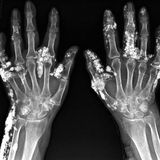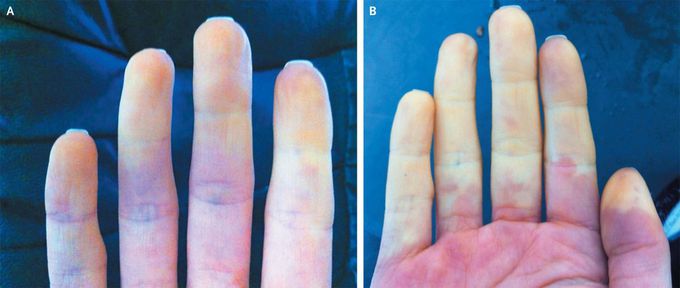


Primary Raynaud's Phenomenon
A 26-year-old woman presented with pain and discoloration in the fingertips of both hands on exposure to cold (Panels A and B). She had had the same symptoms every winter for the past decade. The patient's history and physical examination revealed no signs or symptoms suggestive of systemic lupus erythematosus or scleroderma. She reported that she did not smoke. Her history of a sudden onset of the symptoms is consistent with a diagnosis of Raynaud's phenomenon. Raynaud's phenomenon is characterized by exaggerated vasoconstrictive color changes (pallor and cyanosis) in the fingers, usually due to exposure to cold. The phenomenon is considered primary if there is no evidence of an underlying medical illness. Secondary Raynaud's phenomenon occurs in association with another condition, such as systemic lupus erythematosus, scleroderma, or peripheral vascular disease. The patient was given a recommendation to keep her hands warm to avoid further attacks. Although pharmacologic treatments such as calcium-channel blockers, topical nitroglycerin, sildenafil, and other vasodilators may play a part in the management of Raynaud's phenomenon, this patient did not require any medications for the management of her attacks. Michael Rodgers, M.D. University Medical Center Groningen, Groningen, the Netherlands
Living with Lupus is often a battle not just against the illness itself, but also against the emotional weight of uncertainty, fatigue, and the toll of long-term medications. For one courageous woman, that battle began in 2013. Diagnosed after Lupus had already affected her joints and internal organs, she was quickly placed on medication that initially helped. But as time went on, her health declined again this time with more frequent flare-ups and increasingly difficult side effects. Like many others with chronic illness, she faced the crushing weight of hopelessness. Each day became harder than the last, and conventional treatments no longer offered the comfort they once did. But in March 2020, at her lowest point, she made a decision that changed everything.Out of desperation and with a healthy dose of skepticism she turned to NaturePath Herbal Clinic, hoping their natural Lupus treatment might offer at least some relief. What happened next went far beyond her expectations.After completing a six-month herbal program, her flare-ups stopped entirely. Her energy returned. The chronic pain that had defined her daily life began to fade. For the first time in years, she felt like herself again. Not just alive but truly living.Her story is not just one of healing; it’s one of resilience, open-mindedness, and the courage to try something new when all else fails. By sharing her journey, she hopes to offer something priceless to others living with Lupus: hope.This treatment has been a true breakthrough for her. If you’re searching for a safe, natural, and effective alternative, I genuinely recommend giving this a chance.”www.naturepathherbalclinic.com or email them at info@naturepathherbalclinic.com



